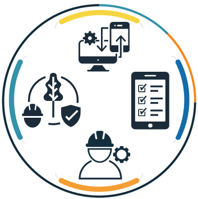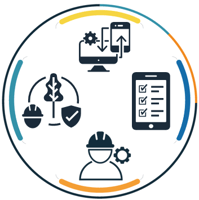4 min read
6 Ways to Improve Mobile App Adoption for Field Workers
By: Ideagen DevonWay on March 5, 2022

Despite spending extensive resources and time to deliver mobile apps for field workers, many organizations face limited adoption that squashes success. But how do you succeed in rolling out mobile apps that your field workers adopt quickly and effectively?
At DevonWay, we've been enabling organizations in regulated, high-risk industries to successfully deliver mobile apps that their field workers use for safety, quality, work management, and more for many years. In the process, we’ve learned what really works. Here are six ways you can improve adoption and use of mobile apps for your field workers.

1. Keep it simple and agile
Perhaps the most important lesson we’ve learned over and over is that well-intended business leaders can inadvertently complicate apps during the requirements phase. Many of those business leaders have told us that after the fact, and they have gone back after rollout to simplify their mobile apps. So start out by keeping it simple and clear to increase adoption and reduce the need for training.
Use an agile development approach that enables you to incorporate feedback. This serves two purposes: (1) You get useful input on how to make your apps more user friendly and easy to use, and (2) You build buy-in and support from your early adopter group.
2. Identify and nurture early adopters and experts
In tech speak, “early adopters” are people who are eager to try new technology – like your friends who always have the latest tech gadgets and are on the next big social app before everyone else. Identify early adopters in your field organization and include them early in the feedback process as you develop apps.
Your “experts” are highly experienced field workers who are used to being the experts in the eyes of their teammates. They don’t want to lose that sense of accomplishment with a new app that makes them feel like beginners. Get their input to reinforce respect for their experience while emphasizing the benefits of new mobile apps.
Your early adopters and experts have an important job to do during the rollout: Build support and buy-in from their peers. Make the adoption process a social experience with conversations paving the way.

3. Create on-demand “micro training”
You can improve mobile adoption by creating bite-sized, engaging trainings online and/or available on demand, ideally from within your apps, that focus on the most critical mobile functions. Encourage collaborative learning where field workers teach each other about the technology. A collaborative learning environment where field workers feel safe to ask each other for help speeds adoption. Studies show that knowledge retention requires repetition.
Making the training available on demand, on the spot when and where it’s needed, means that field workers can get the refresher training they need without the barrier of having to go to class or ask the help desk for assistance.
4. Increase communication and make it safe to ask for help
People need to see a message seven times before they process the message, which means you need to communicate through email, text, face-to-face, message boards, blogs, videos, company meetings, and through your early adopters and experts. What may seem like overcommunication ensures that people “get” the message – but make sure communications are relevant. Get feedback on communication to make improvements along the way. Remember to keep the communication simple, short, and frequent.
Explain the timeline for the mobile rollout. Describe why it is happening. Highlight how your mobile apps improve safety and help everyone be more productive. Prepare specific messages for distinct groups who participate in the adoption of the mobile apps.
5. Be proactive with recognition and incentives
Monitor mobile app usage to measure app adoption. Who’s using it and who isn’t? Are some people or teams clinging to old processes and avoiding the app?
Select simple mobile KPIs and communicate them to your field workers. Provide incentives. For example, measure the total number of forms submitted and recognize the teams who submitted the most forms. Celebrate and reward them in simple ways during meetings and in emails. Take pictures of people using your mobile apps and post the pictures in your internal company communications. You can also provide gift cards or company swag as another form of incentive to increase usage.
If you find that certain individuals or teams aren’t using the new apps, reach out and find out why so you can address issues as soon as possible.
6. Seek feedback early and often
When you implement any new system or process, you'll most likely encounter some issues at the beginning. So seek feedback early and often from your users and be open to making changes that will improve adoption. Ask for feedback in team meetings. Test app usability with intended end users. That creates a culture of trust and shows that you want to make the mobile app as user friendly as possible.
Do you have additional tips for increasing user adoption of mobile apps? We’d love to hear about your experience.
Related Posts
DevonWay ESG & Sustainability: Why and Why Now
On April 12, we announced the launch of the new DevonWay ESG & Sustainability software solution...
Avoid ‘Greenwashing’ with ESG Accountability Support
You may have recently heard the term “greenwashing.” It’s a word no one wants their organization’s...
5 Tips for Chemical Waste Management in EHS Planning
Chemicals and hazardous materials are a part of nearly any industry today, whether an organization...





